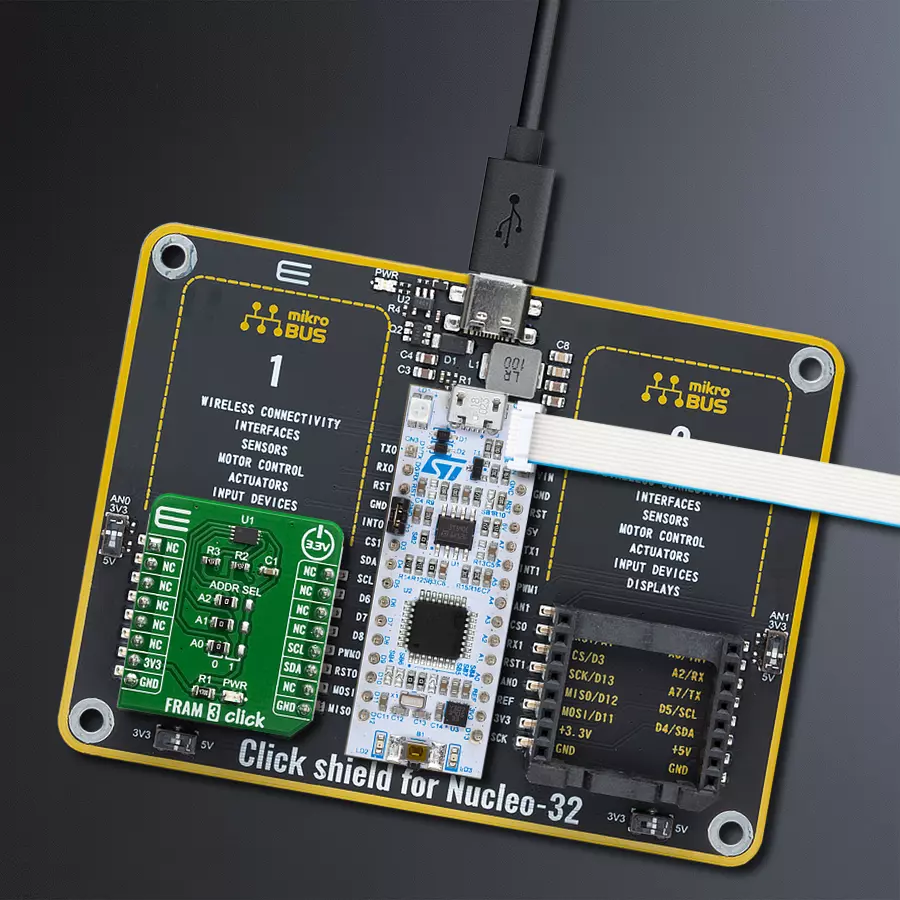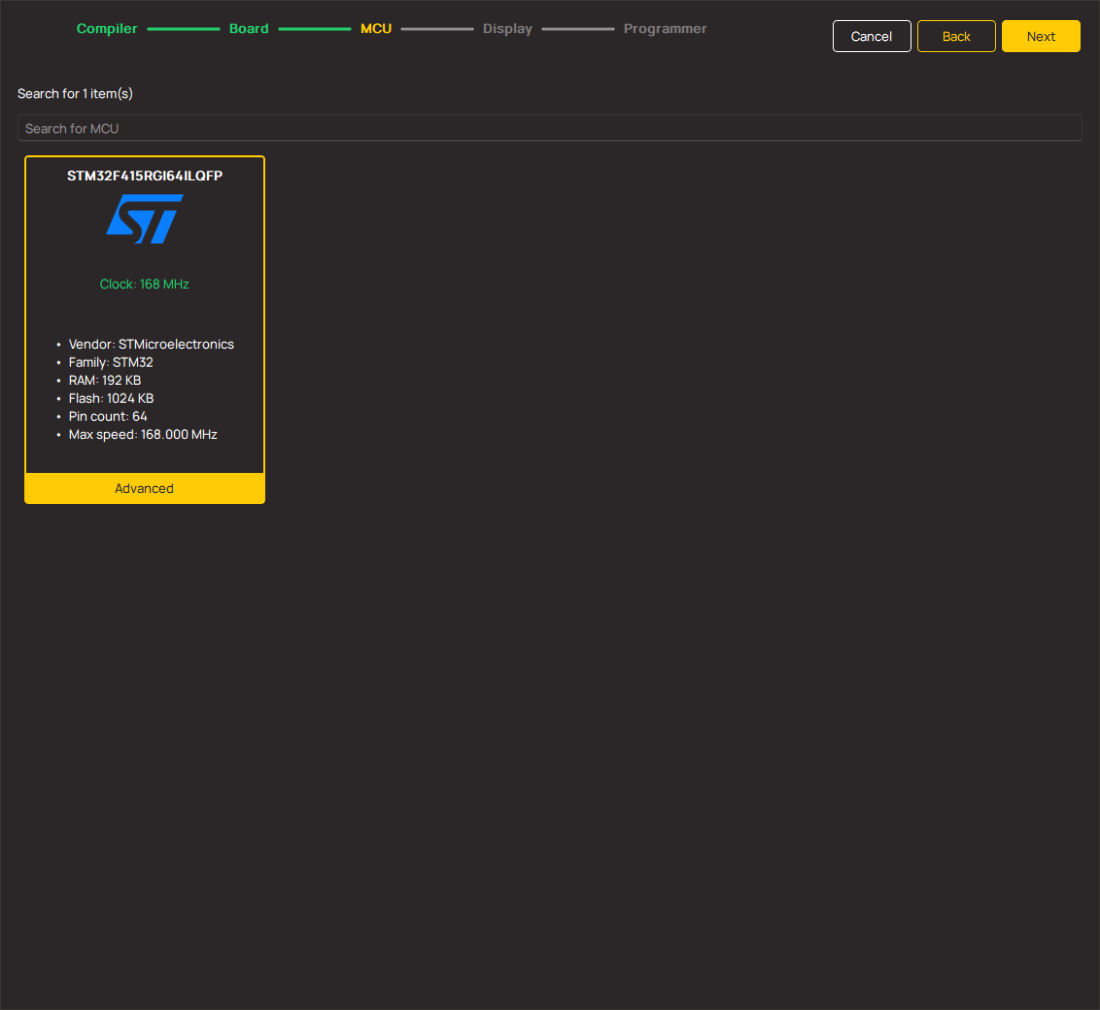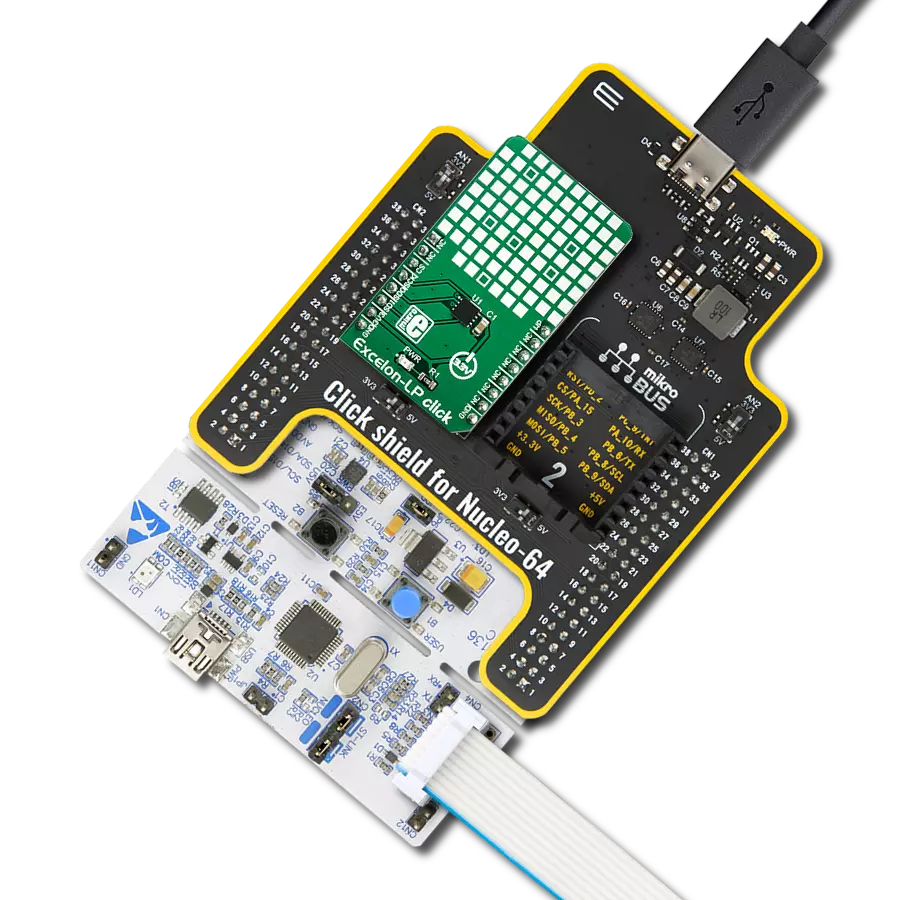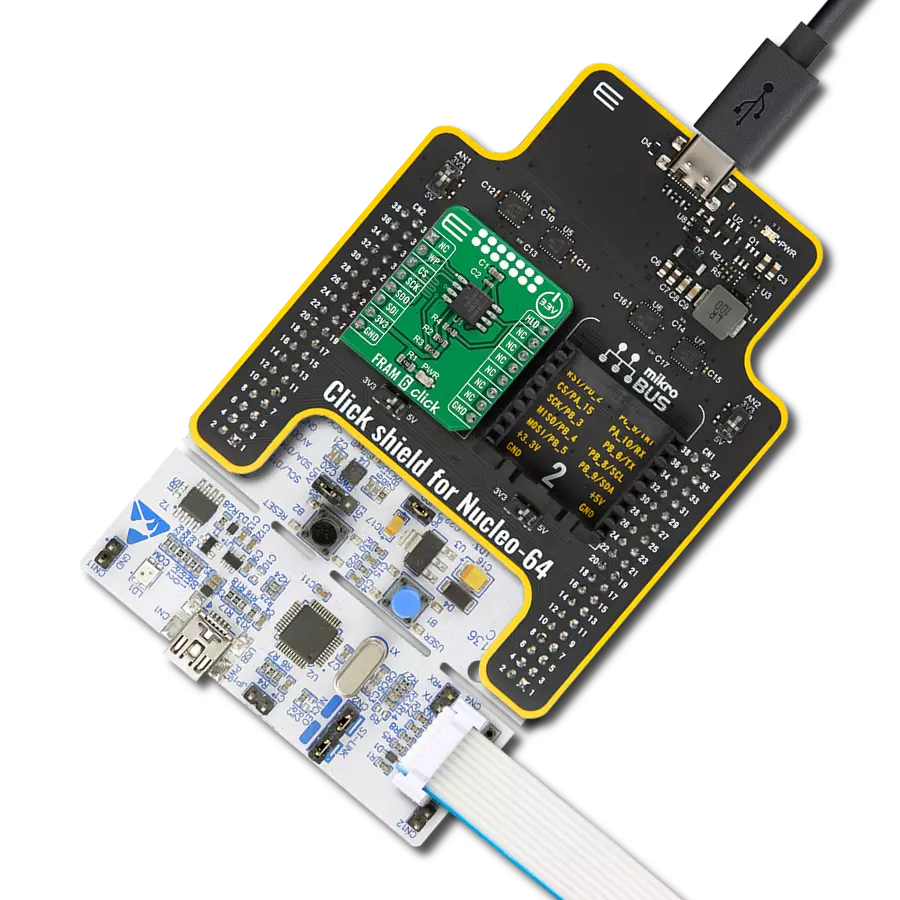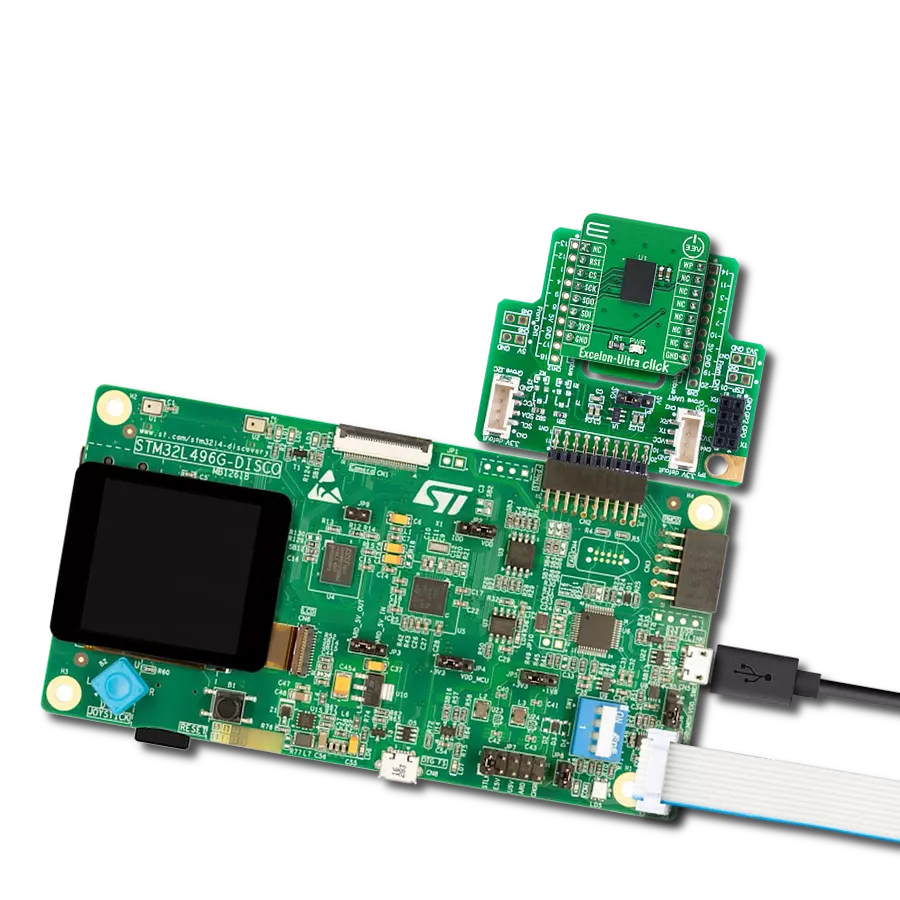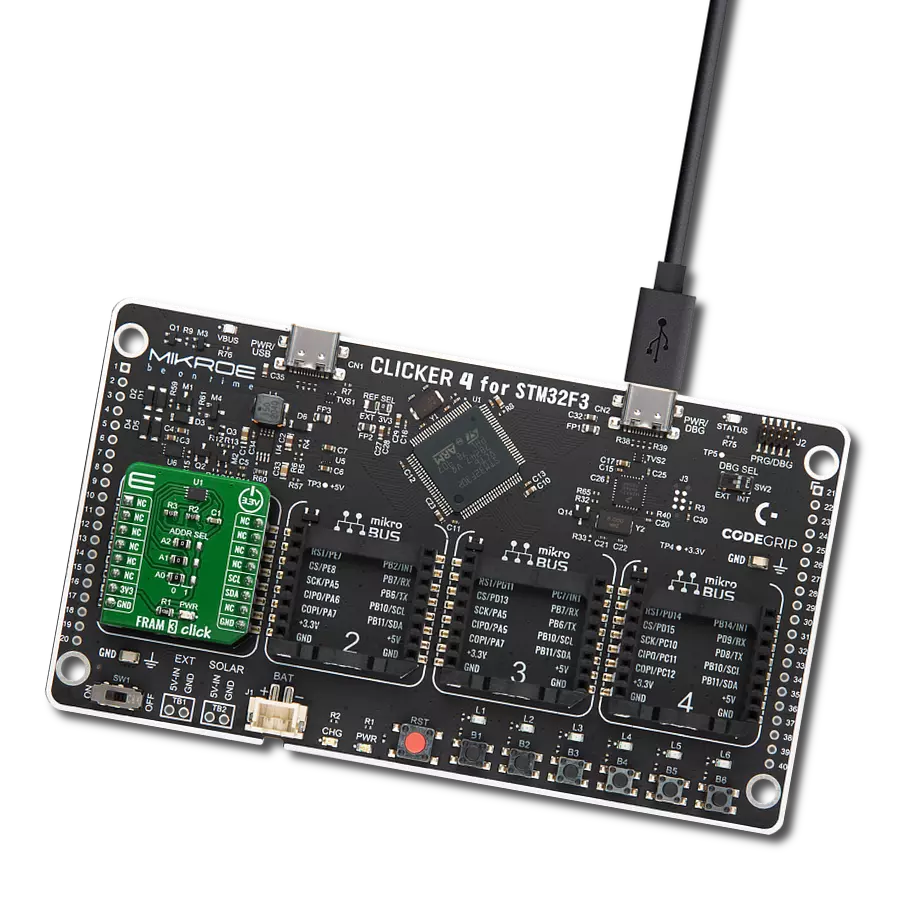Upgrade your design with FRAM memory for unmatched performance and endurance
A
A
Hardware Overview
How does it work?
FRAM 3 Click is based on the MB94R330, a FRAM (Ferroelectric Random Access Memory) authentication IC from Fujitsu Semiconductor, made using ferroelectric and silicon gate CMOS process technologies to form nonvolatile memory cells. The MB94R330 adopts an original communication protocol based on the two-wire serial interface (I2C BUS), a hardware cryptographic macro, and a proprietary control core. It is suitable for detecting cloned peripherals and accessories used in electric equipment such as printers and multifunction printers. Ferroelectric technology is still being developed and perfected, but the advantages have already been demonstrated. This technology exploits the properties of ferroelectric materials to retain the electric field after exposure, the same way the ferromagnetic materials retain their magnetic field. This phenomenon is employed to polarize the FRAM cells and store the information.
One area that still needs improvement is the thermal instability, especially at high temperatures. When the ferroelectric material reaches the Curie temperature, its properties are degraded. Therefore, the high temperature might damage the content of the FRAM module. This is illustrated by the data retention period: while working at 55˚C, the data retention period is ten years. Still, combined with the endurance of 1010 read/write cycles at bus write speed, this type of memory still represents an ideal solution for applications with frequent writing to nonvolatile memory locations. This Click board™ uses the I2C communication protocol, allowing fast serial clock rates. The device employs certain protection mechanisms to ensure reliable data transactions and avoid accidental writing to the memory array. The MB94R330 supports the I2C bus and operates as a peripheral device. The role of the communication for the I2C bus is different from
the "Master" side and the "Slave" side. The master side has the authority to initiate control. Furthermore, the party line can be connected, which connects two or more peripheral devices to one master. In this case, the slave side has a unique address, respectively, and after specifying the address on the slave side, the master side starts to communicate. The FRAM 3 click is suitable for detecting cloned peripherals and accessories used in electric equipment such as printers, multifunction printers, and more. This Click board™ can be operated only with a 3.3V logic voltage level. The board must perform appropriate logic voltage level conversion before using MCUs with different logic levels. Also, it comes equipped with a library containing functions and an example code that can be used as a reference for further development.
Features overview
Development board
Nucleo 32 with STM32F031K6 MCU board provides an affordable and flexible platform for experimenting with STM32 microcontrollers in 32-pin packages. Featuring Arduino™ Nano connectivity, it allows easy expansion with specialized shields, while being mbed-enabled for seamless integration with online resources. The
board includes an on-board ST-LINK/V2-1 debugger/programmer, supporting USB reenumeration with three interfaces: Virtual Com port, mass storage, and debug port. It offers a flexible power supply through either USB VBUS or an external source. Additionally, it includes three LEDs (LD1 for USB communication, LD2 for power,
and LD3 as a user LED) and a reset push button. The STM32 Nucleo-32 board is supported by various Integrated Development Environments (IDEs) such as IAR™, Keil®, and GCC-based IDEs like AC6 SW4STM32, making it a versatile tool for developers.
Microcontroller Overview
MCU Card / MCU

Architecture
ARM Cortex-M0
MCU Memory (KB)
32
Silicon Vendor
STMicroelectronics
Pin count
32
RAM (Bytes)
4096
You complete me!
Accessories
Click Shield for Nucleo-32 is the perfect way to expand your development board's functionalities with STM32 Nucleo-32 pinout. The Click Shield for Nucleo-32 provides two mikroBUS™ sockets to add any functionality from our ever-growing range of Click boards™. We are fully stocked with everything, from sensors and WiFi transceivers to motor control and audio amplifiers. The Click Shield for Nucleo-32 is compatible with the STM32 Nucleo-32 board, providing an affordable and flexible way for users to try out new ideas and quickly create prototypes with any STM32 microcontrollers, choosing from the various combinations of performance, power consumption, and features. The STM32 Nucleo-32 boards do not require any separate probe as they integrate the ST-LINK/V2-1 debugger/programmer and come with the STM32 comprehensive software HAL library and various packaged software examples. This development platform provides users with an effortless and common way to combine the STM32 Nucleo-32 footprint compatible board with their favorite Click boards™ in their upcoming projects.
Used MCU Pins
mikroBUS™ mapper
Take a closer look
Click board™ Schematic

Step by step
Project assembly
Track your results in real time
Application Output
1. Application Output - In Debug mode, the 'Application Output' window enables real-time data monitoring, offering direct insight into execution results. Ensure proper data display by configuring the environment correctly using the provided tutorial.

2. UART Terminal - Use the UART Terminal to monitor data transmission via a USB to UART converter, allowing direct communication between the Click board™ and your development system. Configure the baud rate and other serial settings according to your project's requirements to ensure proper functionality. For step-by-step setup instructions, refer to the provided tutorial.

3. Plot Output - The Plot feature offers a powerful way to visualize real-time sensor data, enabling trend analysis, debugging, and comparison of multiple data points. To set it up correctly, follow the provided tutorial, which includes a step-by-step example of using the Plot feature to display Click board™ readings. To use the Plot feature in your code, use the function: plot(*insert_graph_name*, variable_name);. This is a general format, and it is up to the user to replace 'insert_graph_name' with the actual graph name and 'variable_name' with the parameter to be displayed.

Software Support
Library Description
This library contains API for FRAM 3 Click driver.
Key functions:
fram3_read_free_access_memory- Memory read functionfram3_write_free_access_memory- Memory write function
Open Source
Code example
The complete application code and a ready-to-use project are available through the NECTO Studio Package Manager for direct installation in the NECTO Studio. The application code can also be found on the MIKROE GitHub account.
/*!
* \file
* \brief FRAM3 Click example
*
* # Description
* This application writes data in memmory and reads data from memmory.
*
* The demo application is composed of two sections :
*
* ## Application Init
* Initializes device init
*
* ## Application Task
* Writes and then reads data from memory
*
* \author MikroE Team
*
*/
// ------------------------------------------------------------------- INCLUDES
#include "board.h"
#include "log.h"
#include "fram3.h"
// ------------------------------------------------------------------ VARIABLES
static fram3_t fram3;
static log_t logger;
static char write_data[ 7 ] = { 'M', 'i', 'k', 'r', 'o', 'E', 0 };
// ------------------------------------------------------ APPLICATION FUNCTIONS
void application_init ( void )
{
log_cfg_t log_cfg;
fram3_cfg_t cfg;
/**
* Logger initialization.
* Default baud rate: 115200
* Default log level: LOG_LEVEL_DEBUG
* @note If USB_UART_RX and USB_UART_TX
* are defined as HAL_PIN_NC, you will
* need to define them manually for log to work.
* See @b LOG_MAP_USB_UART macro definition for detailed explanation.
*/
LOG_MAP_USB_UART( log_cfg );
log_init( &logger, &log_cfg );
log_info( &logger, "---- Application Init ----" );
// Click initialization.
fram3_cfg_setup( &cfg );
FRAM3_MAP_MIKROBUS( cfg, MIKROBUS_1 );
fram3_init( &fram3, &cfg );
}
void application_task ( )
{
char read_data[ 7 ];
uint8_t cnt;
uint8_t status_check;
log_printf( &logger, " - Writing... \r\n" );
Delay_ms ( 500 );
status_check = fram3_write_free_access_memory( &fram3, 0x00, &write_data[ 0 ], 7 );
if ( status_check == FRAM3_ERROR )
{
log_printf( &logger, " - ERROR WRITING!!! \r\n" );
for ( ; ; );
}
log_printf( &logger, " - Reading... \r\n" );
Delay_ms ( 500 );
status_check = fram3_read_free_access_memory( &fram3, 0x00, &read_data[ 0 ], 7 );
if ( status_check == FRAM3_ERROR )
{
log_printf( &logger, " - ERROR READING!!! \r\n" );
for ( ; ; );
}
for ( cnt = 0; cnt < 7; cnt++ )
{
log_printf( &logger, " %c ", read_data[ cnt ] );
Delay_ms ( 100 );
}
log_printf( &logger, " \r\n " );
Delay_ms ( 1000 );
log_printf( &logger, "__________________________\r\n " );
Delay_ms ( 500 );
}
int main ( void )
{
/* Do not remove this line or clock might not be set correctly. */
#ifdef PREINIT_SUPPORTED
preinit();
#endif
application_init( );
for ( ; ; )
{
application_task( );
}
return 0;
}
// ------------------------------------------------------------------------ END









